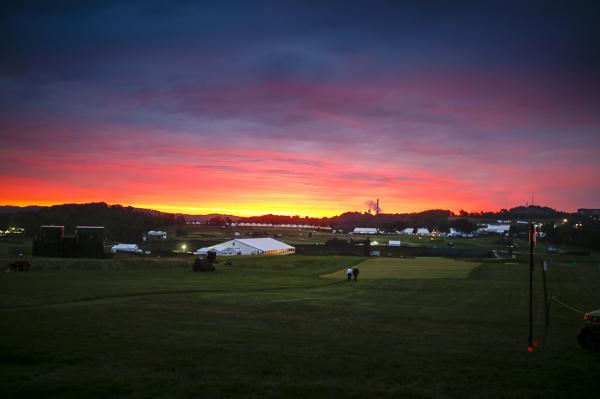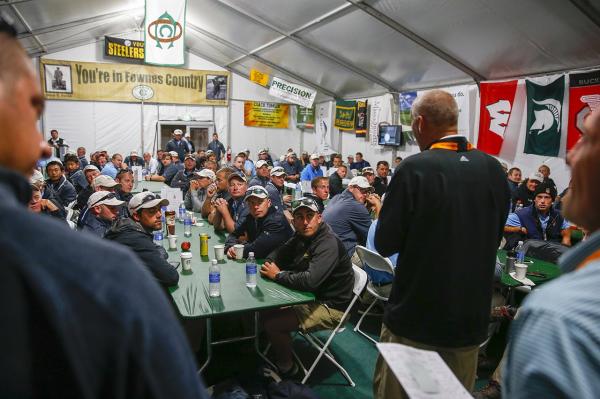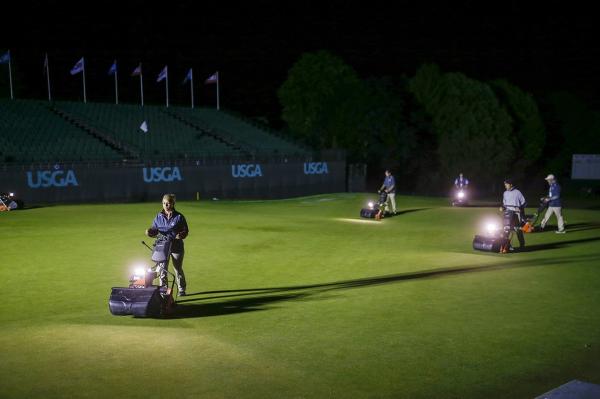
-- BRADLEY S. KLEIN, Golfweek
It's 4:15 a.m. and 140 volunteer superintendents are gathered in a tent, awaiting their marching orders.
They have gathered here from all over the U.S. and from Asia and Europe to help Oakmont's head greenkeeper, John Zimmers, polish Oakmont Country Club for the U.S. Open. They are here to help Zimmers' staff of 50 employees, and the only way to do it is to start early in the day.
That's the nature of the business. If you're not a morning person, you cannot be in this business.
There's Matt Shaffer from Merion, who hosted this event three years ago. And there's Jon Jennings from Shinnecock Hills, which is home to the U.S. Open two years hence. Chris Tritabaugh of Hazeltine Golf Club is getting ready for the Ryder Cup in two months. He's here with friend, colleague and neighbor, Jeff Johnson of the Minikahda Club, home to the 2017 U.S. Senior Amateur.
You know its a classy assembly because they are drinking Starbucks coffee, not just some local sludge. Their temporary quarters sport dozens of colorful banners. Some showcase the flags of prominent turf programs represented: Michigan State, Rhode Island, Ohio State, Penn State. At one end, a huge banner proclaims "You're in Fownes Country", in reference to the founding family of Oakmont. At the other end is a flag in the city's iconic colors of yellow and black proclaiming Pittsburgh as City of Champions and listing the titles of the towns three major professional teams.

Zimmers appears, hushes the group, then launches into a little pep talk that is short on detail because folks like this don't need much instruction. "How does it feel to be the best you can be?" he asks, rhetorically. "Let's have fun, let's stay focused. Take care of each other. Take care of me." Then with a shrug and a laugh he hands things over to his right-hand man, David Delsandro, who without missing a beat calls each name in the room and quickly sends them off to their position on the course.
Fifteen minutes later it's still dark when Zimmers comes by a practice area green to survey the buzz of activity mowing, rolling, changing cups. It always makes me a little nervous to have them working like this in the dark, he says. He likens it to indoor factory production where they've turned out all the lights and have to keep working without loss of consistency or quality.
 Out on the course, each green has to get double-mowed, maybe even triple mowed, then rolled. Then green speed measurements are taken, and the crew is joined by the USGA's setup team to determine the day's hole locations and to look at the likely hole placements for each of the next five days (including the dreaded playoff). Mike Davis, executive director of the USGA, leads the team on the back nine. His setup counterpart for the front nine is Jeff Hall, the USGA's managing director of rules and competitions.
Out on the course, each green has to get double-mowed, maybe even triple mowed, then rolled. Then green speed measurements are taken, and the crew is joined by the USGA's setup team to determine the day's hole locations and to look at the likely hole placements for each of the next five days (including the dreaded playoff). Mike Davis, executive director of the USGA, leads the team on the back nine. His setup counterpart for the front nine is Jeff Hall, the USGA's managing director of rules and competitions.How many people does it take to change a hole location? By the looks of things, about 25. Some take notes for the days pin sheet; yes, even for a practice green. Someone cuts the cup... no easy task. Another changes out the previous cup. Someone carries the flag. Others stand around and talk, including Gil Hanse, golf course architect and FOX Sports golf course analyst for the week, who is taking notes for the days telecast.
Tritabaugh, keen to soak up everything he can in the run up to his Ryder Cup, is standing there on the 10th tee wondering about the mowing pattern. He invokes the face of a clock to describe the lines as 3 to 9, rather than 12 to 6. At the 14th green, he leans over, practically on hands and knees, to observe the characteristics of a ball mark and comment on its turgidity.
A scrum ensues, turfgrass experts and everyday practitioners huddle, someone Googles turgidity and the analysis is confirmed regarding the osmotic flow of water inside the plant tissue. The group then discusses how the ball mark reveals the structure of the underlying soil and how healthy the leaf blade is.

Why would professionals like this give up a week of their lives in mid-golf season to perform the grunt work of tournament set up? Because its like a graduate-level boot camp for them, a chance to engage their colleagues at the highest levels of agronomy and greenkeeping. Instead of having to answer the same basic question over and over to the everyday golfer or to explain things to the same perpetual malcontents, they can engage at a high level of technology and practice. With the opposite of turgid being flaccid, there's no shortage of joke opportunities as well.
At the short, uphill par-4 17th hole, 313 yards long and definitely drivable this week, another huddle ensues, this one involving Davis, Zimmers and Delsandro. The discussion concerns the height of cut in an area short left of the green where many ambitious players' drives will land. At 4.5 inches deep the rough is so tough that a ball could disappear here, and with it, a player's hopes.
Davis wants to increase the potential reward of the risk ratio. After plenty of discussion, they agree to cut back some of the area to 3 inches of rough. It's enough to make a difference. Delsandro and Zimmers walk off an alignment for the adjusted mowing zone, a 10-15 foot wide swing. A promissory note to mow is made. It'll be done that morning.
The setup never stops. The learning never ends.

